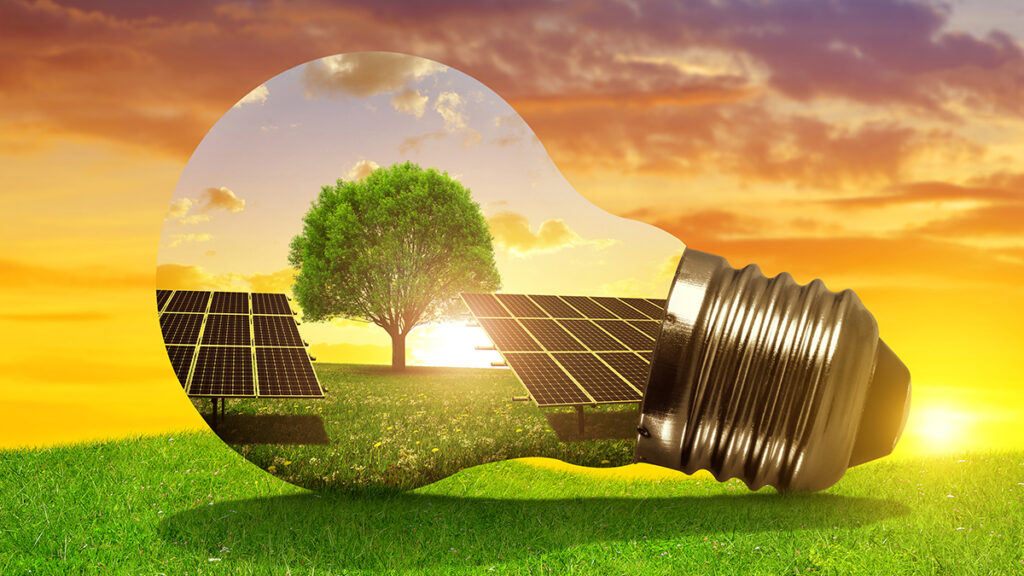
Solar Energy – The endless power of the sun
The sun releases a tremendous amount of energy. Solar radiation is utilized to generate electricity in two ways: with thermal and photovoltaic applications. The first is solar energy collection for heat production (used mainly for heating water and converting it to steam for turbines). In contrast, in the second application, photovoltaic systems convert sunlight into electricity using photovoltaic cells or arrays. This technology, which appeared in U.S. space programs in the early 1970s, has reduced electricity costs, from $ 300 to $ 4 per watt. Photovoltaic systems are mainly used in rural and remote areas where the grid’s connection is costly. Although the whole earth receives sunlight, its quantity depends mostly on the geographical location, the day, the season, and the cloud cover. For example, the desert gets about twice the amount of solar energy from other areas.
The growth of solar energy will lead to the expansion of renewable energy sources within the next ten years, according to the International Energy Agency (IEA).
According to the IEA’s annual World Energy Outlook 2020, clean energy will account for 80% of global electricity demand growth over the next decade.
Hydroelectricity remains the largest renewable energy source, but solar is the primary source of ever-increasing energy, followed by onshore and offshore wind energy.
The development of solar energy will be supported by maturation policies and technologies that will allow very cheap access to capital in the leading markets.
According to the report, solar energy is consistently cheaper than new coal-fired or gas-fired power plants. In contrast, solar projects offer some of the lowest electricity prices ever recorded.
Uses of Solar Energy
Solar Electricity
Solar energy applications have gained a lot of impulse in recent years. As solar panel costs decline, and more people become aware of solar energy’s financial and environmental benefits, solar electricity is becoming increasingly accessible. While still a tiny percentage of the electricity generated in the U.S. (1.9% in 2017), solar electricity is overgrowing (almost tripling over three years and up +40% versus 2016), according to U.S. Energy Information Administration.
A distributed solar P.V. system is often installed on the rooftops of homes or businesses. These energy systems generate electricity to compensate for the house usage and, on the other hand, send any excess production to the electric network.
A solar battery can attach to your solar power system to allow you to use solar after the sun goes down, power an E.V. overnight, or provide backup power during emergencies. Some homeowners may choose to go totally off the network with a solar power and battery system or a solar power and generator system.
In some cases, solar P.V. may be installed on a nearby construction, such as a barn or positioned to the ground and attached to the meter.
Other solar energy uses include utility-scale solar P.V. farms that can generate enough electricity to entire power cities.
An even more effective solar technology is concentrated solar power (C.S.P.). A CSP solar farms uses mirrors to reflect and focus the sun’s energy towards a tower or other receiver, generating heat to power a turbine to create electricity. You can store thermal energy before powering a generator, presenting it as a more flexible electricity source than solar P.V.
The largest C.S.P. solar farm worldwide is the 390 megawatt (M.W.) Ivanpah project in California’s Mojave Desert. Nevertheless, an even larger 580 MW C.S.P. plant under construction in Morocco may soon claim the title.
Solar Water Heating
Solar energy can be used for water heating systems as well. Most of the solar water heating applications create hot water that is consumed inside the house. Solar water heaters apply a rooftop cell to receive the sun’s energy and give it to the water tank. According to the U.S. Department of Energy (D.O.E.), solar water heaters typically have a five to ten-year payback.
Another solar energy application is heating swimming pools, especially in the southern and southwestern U.S. Water is distributed to a receiver where it is heated by sunlight and then drawn back into the pool. The prices are from $3,000 to $4,000, and the payback is approximately 2 to 7 years.
Solar Heating
Typical uses of solar space heating systems include powering radiant floors or pairing with a Forced Hot Air (F.H.A.) system to heat a home. Passive solar home design can also heat homes and businesses in the winter by considering the placement of windows and selecting materials used in the building.
Solar Ventilation
Solar ventilation solutions such as solar attic fans can reduce your HVAC burden by helping to cool your home during the summer. This may be a great alternative if you cannot install a solar P.V. system that supports your home’s entire electricity use.
Industrial and commercial solar process heat applications include solar airing technologies that can preheat a building’s air in cool climates, decreasing energy costs.
Solar Lighting
Solar lights have become universal and can be found worldwide, from the house garden and security lights to street signs and highway lights. These solar lighting technologies for your house are economical and quickly available from basic to high-end designs universally from your regional hardware store to online shopping websites.
Portable Solar
In our interconnected world, mobiles and tablets are always with us and, let’s admit it, usually running low on battery. Portable solar P.V. chargers can keep our electric gadgets charged on the go. The technology now exists to blend solar cells into our phones and has been in watches since the 1970s. In Japan, researchers have even produced lightweight, water-resistant solar cells that could eventually be fastened into clothing to power our devices.
Solar Transportation
Solar-powered vehicles may be, by far, the future, with existing applications including transportation from airplanes, buses trains, to race cars built by students in the U.S.A. and Australia. This use of solar energy is not yet broadly available unless you own electric vehicles or E.V. and energize it with solar panels (usually via a solar-connected battery).
A Solar-Powered Future
Renewable energy is already becoming a more regular part of our lives, and innovation will continue to drive new applications of solar energy technologies that will improve our daily lives and help power a cleaner world.
Did you know that: One of the significant weaknesses of solar energy is that photovoltaic systems cannot produce energy when there is no sun. Some companies, including Tesla, B.Y.D., and Bosch, offer next-generation lithium-ion batteries – such as those driven by electric cars – to store the energy produced by home photovoltaic systems. With these batteries, a house could have power on a rainy day (like today).
The advantage of these systems is that one can have one or two days of energy available for home use in a power outage. It can also decide when to use this energy. In markets where electricity is priced more expensive during peak hours, one could choose to use stored energy for savings.






